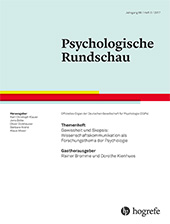Abstract
Zusammenfassung. In diesem Aufsatz entwickeln wir einen hypothetischen Klassifizierungsansatz, in dessen Rahmen wir verschiedene Formen des Verständnisses eines Wissenschaftsbereichs herausarbeiten und deren Bedeutung für die Risikowahrnehmung darstellen. Empirisch kann zunehmendes Verständnis sowohl zur Akzeptanz von Risiken aber auch zu Polarisierung und starker Ablehnung führen; hingegen ist Unverständnis oftmals mit kritikloser Akzeptanz verbunden, ein Phänomen, das wir als Magie des Unverständlichen bezeichnen. Wir schlagen eine Taxonomie verschiedener Modi und Entwicklungspfade von wissenschaftlichem (Un–)Verständnis vor: Aus einer Zone der (a) Ignoranz und Indifferenz führt ein Pfad zu (b) Vertrautheit und Akzeptanz, ein zweiter zu (c) Fragilität und Polarisierung, und ein dritter zur (d) Magie der Unverständlichkeit. Wir beschreiben Charakteristika von Risikobereichen, die beeinflussen, in welche Richtung sich der öffentliche Diskurs entwickelt und diskutieren Implikationen für die Wissenschaftskommunikation.
Abstract. We propose a hypothetical classification of different types of public understanding of science and discuss how these types relate to risk perception. Empirically, an increasing understanding of science may lead to acceptance of risks as well as to polarization and strong rejection; on the other hand, a lack of understanding is often associated with uncritical acceptance, a phenomenon that we call the magic of incomprehensibility. We propose a taxonomy of different modes and paths of scientific (in–)comprehension: From a zone of (a) ignorance and indifference, one path leads to (b) familiarity and acceptance, a second path to (c) fragility and polarization, and a third path to (d) the magic of incomprehensibility. We describe the characteristics of risk domains that affect which path is taken in public discourse, and we discuss implications for science communication.
Literatur
(2017). Dispute and morality in the perception of societal risks: extending the psychometric model. Journal of Risk Research, 20, 299 – 325.
(2005). Consequences, morality, and time in environmental risk evaluation. Journal of Risk Research, 8, 461 – 479.
(2008).
Antinomies of environmental risk perception: Cognitive structure and evaluation . In M. CasimirEd., Culture and the changing environment. Uncertainty, cognition, and risk management in cross-cultural perspective (pp. 61 – 78). Oxford: Berghahn.(2014). The public’s bounded understanding of science. Educational Psychologist, 49 (2), 59 – 69.
(2003). Science communication: A contemporary definition. Public Understanding of Science, 12, 183 – 202.
(1973). Profiles of the future. An enquiry into the limits of the possible (rev. 2nd ed.). New York: Harper & Row.
(1966). Purity and danger. An analysis of the concepts of pollution and taboo. New York: Routledge.
(1992). Risk and blame. Essays in cultural theory. London: Routledge.
(2003). Risk and morality. Toronto: University of Toronto Press.
(2012). The nonsense math effect. Judgment & Decision Making, 7, 746 – 749.
(2005). On bullshit. Princeton, NJ: Princeton University Press.
(2008). Scientific certainty argumentation methods (SCAMs): Science and the politics of doubt Sociological Inquiry, 78 (1), 2 – 38.
(2013). A cooling climate for change? Party polarization and the politics of global warming. American Behavioral Scientist, 57 (1), 93 – 115.
(2008). Morality. Perspectives on Psychological Science, 3 (1), 65 – 72.
(1998). Lay views on uncertainty in environmental health risk assessment. Journal of Risk Research, 1, 261 – 279.
(2011). Cultural cognition of scientific consensus. Journal of Risk Research, 14 (2), 147 – 174. doi: 10.1080/13669877.2010.511246
(2012). The polarizing impact of science literacy and numeracy on perceived climate change risks. Nature Climate Change, 2, 732 – 735.
(1993). Societal risk as seen by the French public. Risk Analysis, 13, 253 – 258.
(2015). Science and the Public: Das Verständnis fragiler und konfligierender Evidenz. Projekte, Forschungsthemen und Ergebnisse aus dem DFG Schwerpunktprogramm 1409 (2009 – 2015). Münster: Universität Münster. http://wissenschaftundoeffentlichkeit.de/broschuere-2/
(2010). Person as scientist, person as moralist. Behavioral and Brain Sciences, 33, 315 – 365.
(2012). Narrative des Risikos. Münster: Waxmann.
(1981). Media coverage and public opinion on scientific controversies. Journal of Communication, 31 (2), 106 – 115.
(2014). Understanding public opinion in debates over biomedical research: looking beyond political partisanship to focus on beliefs about science and society. PloS One, 9 (2), e88473.
(2004). Emotional design: Why we love (or hate) everyday things. New York: Basic Books.
(2015). On the reception and detection of pseudo-profound bullshit. Judgment and Decision Making, 10, 549 – 563.
(2000). The cognitive representation of genetic engineering: Knowledge and evaluations. New Genetics and Society, 19, 295 – 316.
(2001).
Decision making in the context of environmental risks . In C. M. AllwoodM. SelartEds., Decision making: Social and creative dimensions (pp. 89 – 111). Dordrecht: Kluwer.(2005). Risikowahrnehmung. In D. FreyL. von RosenstielC. Graf HoyosHrsg., Wirtschaftspsychologie (S. 310 – 315). Weinheim: Beltz PVU.
(2012). Emotion und Moral bei der Risikowahrnehmung. Spektrum der Wissenschaft SPEZIAL, 1/12, 66 – 73.
(1997). Risiko- und Technikakzeptanz. Berlin: Springer.
(2013). Easy to understand but difficult to decide: Information comprehensibility and controversiality affect laypeople’s science-based decisions. Discourse Processes, 50, 361 – 387.
(2012). The seduction of easiness: How science depictions influence laypeople’s reliance on their own evaluation of scientific information. Learning and Instruction, 22, 231 – 243.
(2014). Addressing challenges to public understanding of science: epistemic cognition, motivated reasoning, and conceptual change. Educational Psychologist, 49 (2), 123 – 138.
(1987). Perception of risk. Science, 236, 280 – 285.
(2000). The perception of risk. London: Earthscan.
(1998). Fashionable nonsense: Postmodern intellectuals’ abuse of science. New York: Picador USA.
(2009). If it’s difficult to pronounce, it must be risky. Psychological Science, 20 (2), 135 – 138.
(2010). The Guru effect. Review of Philosophy and Psychology, 1, 583 – 592.
(2001). Mere exposure: A gateway to the subliminal. Current Directions in Psychological Science, 10, 224 – 228. doi: 10.1111/1467-8721.00154
(1999).
Gentechnik im Verständnis der Öffentlichkeit – Intimus oder Mysterium? . In J. HampelO. RennHrsg., Gentechnik in der Öffentlichkeit, (S. 98 – 132). Frankfurt a. M.: Campus.(2002). Euphorie und nagende Ungewißheit: Wie akzeptabel ist der Mobilfunk? Gaia, 11 (2), 150 – 152.



